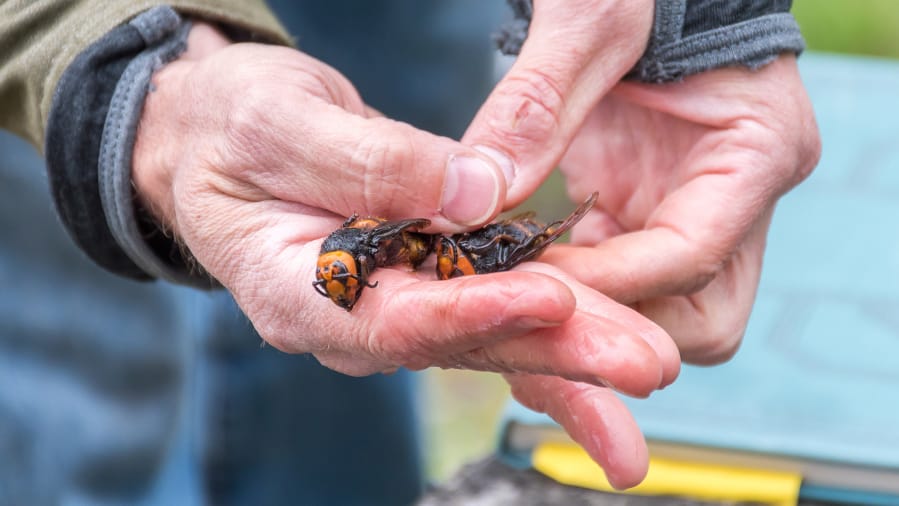SEATTLE — The Pacific Northwest could be the perfect habitat for the Asian giant hornet — known to some researchers as the “murder hornet” — which could decimate honeybee populations throughout Western Washington and down the coast if “aggressive efforts” aren’t taken to quickly eradicate it, according to a new study from local experts.
The study, published Sept. 22 in the Proceedings of the National Academy of Sciences by researchers from Washington State University and the Washington State Department of Agriculture, mainly focused on analyzing the hornet’s potential spread in North America and which environments it usually thrives in.
“If the insects did become established in the U.S., there’s a lot of potential good habitats for it,” said Dr. David Crowder, an entomology professor at Washington State University and one of the authors of the study.
The world’s largest hornets — insects that can be nearly 2 inches long, with a distinct orange face and dark, teardrop-shaped eyes — generally thrive in habitats with cool to warm temperatures and high precipitation, he said. In their native habitat, they usually live near mountain foothills in forests.
“And that describes a lot of Washington, especially west of the Cascades,” Crowder said, adding that his team didn’t find evidence Central and Eastern Washington were as at risk of seeing a spread.
While the “murder hornet” moniker seemed to spread panic among Americans earlier this year, Crowder said they don’t generally attack people unprompted and we shouldn’t be too afraid of them.
“The name ‘murder hornet’ worries a lot of people,” he said. “And while it’s true the insects can kill people if they sting you enough times or if you have an allergic reaction to the sting, that’s not fundamentally different from other wasps and bees that can also kill people.”
The more pressing concern, he said, is the damage the hornets could wreak on honeybees and native insects.
The hornets, which decapitate bees, bring them back to their hive and feed them to developing larvae, can slaughter an entire honeybee colony in a few hours. Because most bees in North America don’t have natural defenses against the giant hornet, Crowder said, a significant spread could devastate the bee population and beekeeping industry.
Fortunately, he said, we’re still in the “introduction” phase, and there currently aren’t any active, established nests in the U.S.
“We’re hoping we can nip this in the bud and prevent it from establishing and spreading down the coast,” Crowder said. “But without the aggressive human effort to contain it, it could spread really quickly.”
Their presence in the U.S. was first documented late last year in Blaine, Whatcom County. Since then, WSDA has launched a concerted effort, recruiting both researchers and volunteers, to find and trap any hornets in the region. In July, they trapped the state’s first hornet near Birch Bay in Whatcom County, a step officials hoped would lead them closer to the eradication of the invasive insects from the country.
As of Sept. 22, more than 1,300 traps had been set, mostly in the northwest part of the state near the Canadian border, Crowder said. In total, 10 hornets — three of which were queens — have been found in Washington, and three have been found in British Columbia, he said.
Some WSDA researchers are also in the process of developing stronger traps by synthesizing a pheromone that attracts the insects, Crowder said.
But the state is still asking for help. WSDA is urging anyone who sees an Asian giant hornet or evidence of a hive attack to report it by filling out a form on WSDA’s invasive hornets website or emailing hornets@agr.wa.gov. More information about what to look for and how to identify a giant hornet can be found on the website.
“I think a lot of us are very hopeful we’ll be able to contain the population before they get out,” Crowder said. “But in case this invasion were to spread, our paper can be used to proactively assess areas where the insect might be able to reach and how quickly they can move throughout the landscape.”



